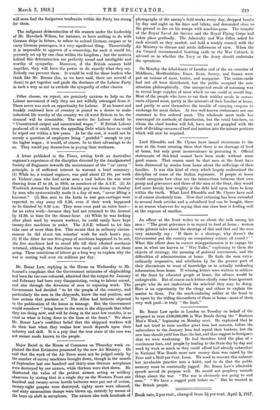A letter published in the Times, setting forth an Australian
engineer's experience of the discipline directed by the Amalgamated Society of Engineers towards the maintenance of the " ea' canny " principle, is of sufficient interest to warrant a brief summary. (1) While he, a trained engineer, was paid about £3 10s. per week at Vickers', men who had never seen a tool before the war were drawing from £7 to £8, in 1916, as members of the A.S.E. (2) At Woolwich Arsenal he found that double pay was drawn on Sunday by men who systematically made it a day of rest, " never lifting a hammer." (3) Men sent to the butts to test gun-carriages were expected to stay away till 5.30, even if their work happened to be finished by 9.30 a.m. They were even paid an extra hour— for no extra work—because they had not returned to the Arsenal by 12.30, in time for the dinner-hour. (4) While he was looking after plant used by women workers, he could easily have kept twenty-five machines in order. The A.S.E. refused to let him take care of more than five. This meant that in ordinary circum- stances he did about ten minutes' work for each hour's pay. (5) If the fitter for one five-group of machines happened to be out, the five machines had to stand idle till their allotted mechanic returned, although the Australian was ready and able to set them going. These conditions of labour go a long way to explain why the war is costing well over six millions per day.


























 Previous page
Previous page